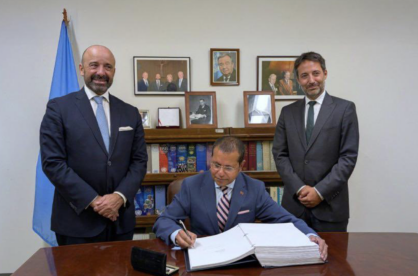Augmented Reality in learning
The Hologo app is revolutionising education.

Hologo Image
The Hologo app is revolutionising education.

Hologo Image
Augmented Reality (AR) is transforming the traditional methods of learning practice in our nation. In the early days, people learnt simple Dhivehi, Arabic and Arithmetic by writing letters in sand and went to traditional schools called “Edhuruge,” generally under a tree or large room at any neighboring house known for teaching a group of children. With western style schools introduced in 1927, teachers used chalk boards, which were later upgraded to White Boards in classrooms.
Today, in the digital era, schools are largely adapting to the concept of digital learning in classrooms using projectors, tablets, and laptop computers. Methods of online education were adopted in 2020, with school closures due to the COVID-19 pandemic. The Maldivian-owned Hologo application is aiming to revolutionize the current digital learning techniques, from 2D to 3D models of learning through AR technology.
The story of Hologo began in September 2017, when its founders were invited to showcase AR educational demos at an Apple Distinguished Schools training seminar in the UK. With the positive comments received from innovative educators in the forum, the team focused on developing the Hologo Application with the aim of revolutionizing the education industry in the Maldives.
‘The idea of AR applications in learning was initiated while working in Islanders Education. We had difficulties sharing content with regional schools. While we created video series, we wanted to create an interesting way using 3D models. At the time Apple also announced integration of AR technology in iPhones, hence we decided on adding a few models to the video series. The students and teachers were very fascinated with the new learning experience and showed improvements in interactivity and engagement of students.”
“Augmented Reality Technology is believed to be an important model for the coming years. AR technology is embossing real world experiences to Digital platforms.”
Eedham believes that after Mobile phones, the next era will be of wearable devices with AR technology integrated. With such devices introduced, 3D models will become more appealing to people than 2D models. According to technology expert Tom Emrich, “AR is a technology that enhances or augments your experience of the world around you.” At its most basic level, AR integrates and adds value to the user’s interaction with the real world.
Today, AR is gaining share in the commercial market due to its ability to facilitate tasks, provide access to resources and solve complex problems. IDC predicts that worldwide spending on AR will reach $160 billion in 2023, a significant increase from $16.8 billion forecast for 2019. Industries such as manufacturing, telecommunications, retail, healthcare, and education are increasingly adopting AR for variety of uses.
Founded by a team with shared values of changing the world, Hologo is actively engaged in bringing education and technology together through AR applications in learning. With the help of a multi-diverse team from UK, Finland, India, and Australia, the Maldivian-owned Hologo app was able to reach 37th in the rank of Apple’s top applications in the Education category. Since then, the Hologo app has been used worldwide in many countries such as Finland, Brazil, Australia and India.
The app features a constantly growing library of 3D and AR integrated lessons on various STEM field modules, geography, animals and journeys through astronomy, countries and wonders of the world. Each lesson consists of audio explanations, 3D observation and students can attempt a quiz related to topic. The app allows teachers to modify integrated lessons with audio explanations as well.

Hologo has been involved in testing AR applications in the education sector through various efficacy studies. According to Eedham, a study was conducted to analyze improvements of student learning through AR application, where two classes was taught by the same teacher using AR application in class A and without AR in class B for one whole term. The results of the study indicated an 87% improvement in class A where AR application was integrated with visual learning. The feedbacks from students indicated that 97% of students find AR application more engaging in lessons compared to traditional methods while 61% of students re-visited the lessons after school at home. The method was shown to be more effective for student comprehension, engagement, and interaction during teaching sessions.
Apart from schools, tertiary education institutions also have high potential for using AR technology, especially in STEM field modules such as engineering and medicine. With more engagement and interactive features implemented in AR learning, engineering students can perform practical lessons through AR demos. Likewise, medical students can learn human anatomy, specific organs and also simulate surgery without an actual human body.
Today, Hologo has representation in the United States, United Kingdom, Australia, Canada, Brazil, Vietnam, Sri Lanka, Malaysia, Indonesia and Turkey. The team is driven to improve the contents of the app as well as the current limitations of the platform. During the interview, Eedham explained that the team is currently aiming to upgrade its platform in the fourth quarter of 2021, into a robust solution supported by the Web and mobile phones. With the upgrade, more people can access the platform through their laptops and a wide array of mobile devices.



